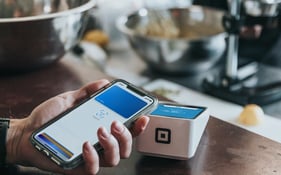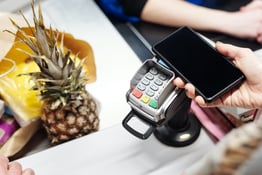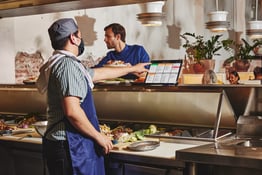Partnering with a delivery service can be a great move for your restaurant and your customers. For restaurant operators, a third-party delivery service or app expands your client base beyond your neighborhood. And when a restaurant hires a service, dedicated delivery drivers come included. For customers, it makes ordering easy and accessible. When they order through a delivery service, people know their order has zero chance of being misunderstood over the phone, and they don’t have to read a credit card number aloud.
The proposition felt like a win-win even before the pandemic increased the value of smooth, reliable delivery. Since early 2020, though, the value of using a delivery service has only climbed.
Before Covid, working with a third-party service was shown to raise sales between 10 to 20%. Yet from February to April of 2020, there was an 840% increase in weekly sales via online ordering, a trend that held across suburbs and cities alike. Gross third-party delivery sales essentially doubled in the United States during 2020, a tremendous leap in an already-growing industry. Gross third-party delivery sales essentially doubled in the United States during 2020, and the growth, albeit slower, has continued into 2021.
So which, if any, third-party delivery service is best for your restaurant? With any of the following services, you'll get a well-oiled delivery system ready to plug-and-play for your business. With all of the top options, food delivery contractors are part of the package, which means you don't have to have an existing delivery system or workers in place.
In the fine print, though, you'll find the trade-offs for such speed and reach. Particularly the commission rates — basically, the slice of a regularly priced menu item that the platform charges you on each order as payment for your restaurant existing on the platform — can be prohibitive. Some have climbed high enough that local governments have stepped and voted to cap the fees until the full return of in-person dining, a motion that officials are now pushing towards permanent legislation, even as delivery services push back.
Actions to limit fees to around 15% have been put forward by New York City, San Francisco, and the state of Texas, for example, and these government bodies are far from the only ones eying third party delivery’s dizzying markups. Commission-free ordering services like ChowNow center their marketing materials on cost savings.
This is a clear case of "your mileage may vary." (One tip, always: Negotiate upfront.) Getting into business with these platforms is a big decision, with a lot of dollars in the balance. So we’ve built this roundup to help you examine each company — its fees, current technologies, perks, and partnerships — so you can better decide which of these delivery giants can help you grow your customer base. And if it turns out none fit your bill, perhaps you start your own delivery service.
So which service (or services) should you choose? Here's a closer look at some of the most popular and promising options out there.
DoorDash
A good choice when you want reach, scale, and a user-friendly software. Has about 56% of the national market share (including its subsidiary, Caviar).
From 2019 to 2021 DoorDash saw a rise of more than 2 million “dashers,” with a pretty profit to match. A nifty company toy is its recently launched Storefront, an online ordering platform that allows for customizable and commission-free ordering for DoorDash clients. Your orders route like DoorDash orders, and delivery drivers are automatically connected.
Pricing and fees
Commission rate: In April DoorDash started offering tiered commission for independent restaurants, but these rates only start at 15%, and choosing the lowest plan means your customers will pay higher rates. The top tier is 30% which, if commission caps are successful, will be twice the legal limit in most major cities. Yikes! (At least some of those fees support the company’s ongoing Main Street Strong Accelerator program, which gives restaurants owned by women, immigrants, or BIPOC access to financial support and training.)
What the customer pays: The price of the menu items, tax, an optional tip to the Dasher, a delivery fee ($5 to $8), and a service fee which depends on the restaurant. There may also be a fee if the order is small or if demand is high.
Ordering protocol: You’re able to choose between four systems, receiving orders via email, fax, DoorDash tablet (for $6 per week), or POS integration. More on that here.
Caviar
A good choice when you want an easy start into third-party delivery.
Its name connotes luxury, and this app generally offers delivery from high-end restaurants that don't have relationships with other delivery apps.
Before Caviar was acquired by DoorDash in 2019, the service was beloved for paying couriers well and turning a decent profit. That shifted in 2020, when Caviar’s integration with DoorDash spawned a host of tech issues. And while the new system has worked out the kinks, its rocky journey left a trail of now-outdated information online. Keep all this in mind when you read positive and negatives of reviews of Caviar, and call customer service with important questions.
Pricing and fees
Commission rate: Around 20%, just like daddy DoorDash.
What the customer pays: Pretty much the same as DoorDash — menu item price, tax, tip to the Dasher, delivery fee between $5 and $8, service fee, and potential fees for small orders or when demand is especially high.
Ordering protocol: Ditto DoorDash. At this point both DoorDash and Caviar merchants use the same portal, and account logins are interchangeable for both restaurant and customer.
>>>RELATED: How Restaurants Can Use Technology To Improve To-Go Sales
Grubhub
A good choice when you have money to spend on gaining exposure, or if your primary focus is sheer volume. Has about 17 percent of national market share, including its subsidiaries.
After swallowing Seamless in 2013, Grubhub was acquired in June 2020 by a Dutch company called Just Eat Takeaway that has delivery down to a science. More than 85% of restaurants said that Grubhub increased the volume of takeout and delivery orders for their businesses. The drawback is, again, steep commission fees.
One of Grubhub's biggest selling points is a recently introduced technology suite called Ultimate. The Ultimate landing page reads like a bad apartment listing (GOOD SERVICE. REDEFINE PROCESS. SAVE MONEY!!!) but it’s basically a POC hardware and software that connects the front and back of house.
Pricing and fees
Commission rate: The commission rate is a flat $15, but Grubhub’s fees are exceptionally high, and you pay even steeper commission rates for greater visibility on the app. Consider the numbers in this viral post, wherein a restaurant earned $1,042.63 in orders but only received $376.54. Puny net returns to restaurateurs have made Grubhub the target of several slam pieces that have bruised its public perception.
What the customer pays: Price of the menu item, tax, the aforementioned commission rate, a delivery commission rate (between $4 and $8), a phone order commission rate, an order processing fee, and a pay-me-now fee for restaurants to get the customer’s money faster — it still might take 3-4 business days, though. In total this will take another 10% or so of your profit per meal.
Ordering protocol: Grubhub is nudging restaurants away from “middleware” and towards POS integration, touting an impressive mosaic of marketplace and branded channel partners. The aforementioned Ultimate platform includes a (POS) system that integrates into Grubhub's apps, a kitchen display system, in-store kiosks for customers, and a customer display for ordering time estimates. You can still use tablets and compatible systems, but it’s going to feel more complicated.
Seamless
A good choice when your customer base got used to Seamless before Grubhub scooped it up. But it won't be around much longer.
Its name has become practically synonymous with online food delivery, making Seamless the Xerox or Band-Aid of its industry. That brand recognition adds value, especially in major cities. Since everyone's heard of it—and their friends and colleagues are all using it—people are likely to download the app (and thus to consider your restaurant). One downside: critics have complained that Seamless extracts too much in fees, as much as 30%.
Seamless was acquired by Grubhub back in 2013, so they’ve had a lot of time to work out the kinks in couples therapy. They maintain their own apps and don’t share a fleet of riders like DoorDash and Caviar, but almost everything else — finances, perks, POS options — is the same.
One catch: Seamless as a brand is about to be fully absorbed by Grubhub, now that Grubhub has merged with Just Eat Takeaway. The CEO said in July that Seamless as Americans (and New Yorkers, specifically) have known it won't be a standalone brand much longer. Long live the king.
Pricing and fees
Commission rate: Falls around 15%. Unlike at Grubhub, you can’t pay a higher commission fee for additional exposure.
What the customer pays: Same as Grubhub.
Ordering protocol: Same as Grubhub.
>>>RELATED: Uber Eats wants to be more than just your delivery app
Uber Eats
A good choice in places where customers are used to using Uber for rideshares, or if you want to keep your own data. Commands about 20% of the national market share, excluding Postmates.
Uber Eats may be the least expensive app for customers, which savvy restaurant-goers may value. Probably more importantly, people who regularly use Uber as a ride-sharing service earn points that can lead to free food delivery.
You might also appreciate that the Uber Eats Manager mobile app places a new emphasis on data autonomy. It lets restaurants track sales volumes, operational stats, earnings, and issues that arise during delivery.
Pricing and fees
Commission rate: from 15%-35%.
What the customer pays: The price of the menu item, tax, delivery fee (that depends on the restaurant), a service fee (15% of the order), and possibly a small-order fee.
Ordering protocol: UberEats offers a variety of POS options. It can integrate your current system to UberEats, deliver software to run in the background of your current system, or help your current POS provider connect to the company’s interface.
Postmates
A good choice if you still root for and like working with smaller operators. Has about 6% of the national marketshare.
In 2020 Uber gobbled up Postmates, a relatively small player in this field, for $2.65 billion. If you’re going to sign up with Postmates now, you get to take advantage of Postmates’ partnership with Ordrslip, a software that allows restaurants to create custom mobile apps. Uber doesn’t offer Ordrslip at this time, and Ordrslip even throws a little shade at UberEats in its marketing materials.
Pricing and fees
Commission rate: from 15%-35%
What the customer pays: The price of the menu item, tax, a delivery fee of around $5, a 9% service fee, and a tip (which is typically a bit higher than UberEats).
Ordering protocol: Same as UberEats.
[Photo by Creative Vix from Pexels]





